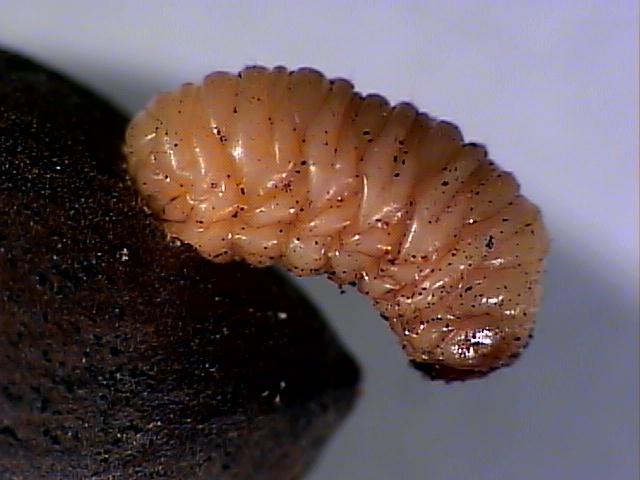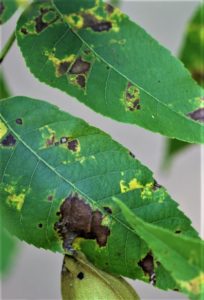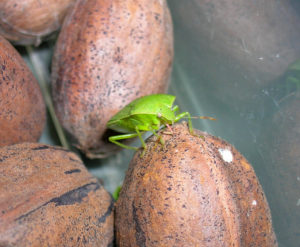Keeping up with late-season pests

If I had a choice of battling pecan weevil or stink bugs, I would choose pecan weevil all day every day. The host range of the pecan weevil includes hickory and pecan and, thus, limits the points of attack. Additionally, the pecan weevil’s biology combined with the host plant’s phenology determines when the pest will attack—whereas stink bugs are full-season pests.
This does not mean that the pecan weevil is not a threat; it can be a devastating pest if left to its own devices. But with a well-directed effort toward monitoring and treatment application, pecan weevil attacking a commercial orchard is no match for the management options that can be levied against it. The 2022 Commercial Pecan Spray Guide published by the University of Georgia lists numerous products effective against the pecan weevil—just be sure to read product labels for use in your state.
Successful pecan weevil management starts with monitoring. There are plenty of trapping options for this job, whether it is the Circle trunk trap, Tedders pyramidal trap, cone emergence traps, or burlap bands around trunks. I’ve used many different traps for monitoring, and the Circle trunk trap remains my favorite for its simplicity and placement on the trunk—out of the way of orchard equipment. Even trunk placement can be managed such that it does not interfere with pecan shakers.
However, any trapping method that reliably captures pecan weevil adults can be used to determine: 1) orchards or locations within orchards where weevils are most abundant, and 2) when treatment applications should be applied.
Applying treatments without knowing where the weevils are or when they are there just does not make sense. A calendar spray schedule may be convenient, but it is not efficacious for weevil control because emergence can vary from year to year. For instance, drought conditions can delay weevil emergence leading to the necessity of postponing a weevil treatment application. A calendar spray schedule may have you spraying too early or too late, and you will not know until harvest. Concentrate your trapping effort in parts of the orchard with a known infestation or, if your orchard is free of weevil, along orchard edges where immigrating weevils will approach. We know that when pecan weevil comes from within the orchard, it represents a previous control failure. You should strive to battle weevils immigrating from host plants outside your orchard rather than fighting chronic populations within your orchard every year.
Although immigrating weevils will fly to your orchard directly into the pecan canopy, their behavioral response to disturbance is to drop to the ground. Upon recovery these weevils will move to the pecan tree, and a percentage of the immigrating population will be captured in traps and alert you to their presence. The monitoring methods for pecan weevil plus the availability of efficacious products, regardless of where the pecan weevils come from, should combine to make short work of this pest. If not, reconsider your approach.
Stink bugs attacking pecan include several species, each with somewhat different biology, leading to a complication of control. This pecan-attacking group of stink bugs feeds on a wide range of host plants from early spring to late fall. And just for fun, let’s add an invasive stink bug species into the mix, i.e., the brown marmorated stink bug, whose geographic distribution is not settled yet but absolutely will feed on pecan. What could go wrong?
With such a wide host plant range, stink bugs operate at a landscape level and your orchard is just a component of that large area. My recent work with colleagues on stink bugs concerns their spatiotemporal distribution across landscapes—in other words, where they are at different times of the season. We find that stink bugs move in response to host plant availability. For instance, the green stink bug (Chinavia hilaris) completes its first generation of the season on trees such as black cherry and elderberry before dispersing to other host plants. Piecing together this information for the different stink bug species will allow us to develop stink bug risk ratings for pecan orchards based on surrounding habitats.
During the late season, stink bugs commonly disperse into pecan orchards in response to row crop harvest or declining quality of host plants around pecan orchards. And be aware that stink bugs seem to favor orchards during drought conditions. Once in the orchard, stink bugs feed on pecan kernels through the shuck and hardened shell. The hardened shell is no match for a hungry stink bug.
Again, monitoring is key to successful management. Pheromone traps (yellow Tedders pyramidal trap + commercially available stink bug aggregation pheromones) can help monitor the brown stink bug and the invasive brown marmorated stink bug. Unfortunately, pheromone lures are not available for all stink bug species attacking pecan. Pheromone traps are most useful in detecting changing stink bug populations (increasing/decreasing). Sampling terminals generally yields few stink bugs, and it is hard to gauge how to interpret these low numbers.
Other than the pheromone trap, insecticidal knockdown sprays are a good method for determining increasing/decreasing stink bug populations. When you do treat for stink bugs, better control is achieved when using pyrethroid insecticides, and the addition of thiamethoxam generally increases the efficacy of the pyrethroid used. Be aware that using pyrethroids can easily cause a flare-up of mites and aphids.
Late-season hickory shuckworm infestations can be a serious problem preventing the pecan shuck from splitting normally, leading to sticktights. This pest often is controlled inadvertently during the late season by products primarily used against pecan weevil and/or stink bugs. When hickory shuckworm is the primary target, monitoring can be done using pheromone traps or blacklight traps. In either case, you must be able to identify captured shuckworm adults.
Before the shell hardens, aborted nuts on the ground can be sampled for shuckworm oviposition markings. Nuts are aborted because the shuckworm already made it into and fed on the nut. But after the shell begins to harden, infested nuts will not abort, so reliance on monitoring shuckworm populations becomes more important. Because the shuckworm larvae soon tunnel into the shuck after hatching and are safe from your preventative measures, it is important that insecticide applications are on the nut ready to protect against shuckworm entry. The approach here is like managing pecan nut casebearer—do not allow nut entry. Several products are available for managing shuckworm (again, see the 2022 Commercial Pecan Spray Guide).
The black pecan aphid is a late-season pest capable of doing great harm by feeding on leaves and eliciting chlorotic lesions. An accumulation of these lesions leads to leaflet abscission, and an uncontrolled population of this pest will cause economically injurious levels of defoliation. Although pecan cultivars exhibit varying degrees of susceptibility to black pecan aphid feeding through much of the season, by late season all pecan cultivars are nearly equally susceptible to black pecan aphid feeding damage.

Feeding injury by the black pecan aphid remains even after the aphid is gone. Over time, these yellow spots will turn brown. Once this injury has been done, no treatment can undo the damage. (Photo by Ted Cottrell)
Because of increasing susceptibility as the season progresses, it takes a lower number of the black pecan aphid to trigger a treatment application by late season. At this time of year, natural enemies cannot respond fast enough to maintain black pecan aphid numbers below the population threshold that will cause economic injury, so intervention will be necessary.
Numerous insecticidal control options plus gibberellic acid are available, and many of these can do a great job if you stay in front of the black pecan aphid (see the 2022 Commercial Pecan Spray Guide for sampling recommendations and products). Regardless of what you apply, once the damage is done, it is permanent for the season because the chlorotic lesions will remain on the leaf and eventually turn brown if the leaflet does not abscise.
Late-season pest control is critical to saving the nut crop this season and allowing the tree to prepare for next season’s crop. Be wary of these late-season pests and the damage they cause. Arm yourself with an understanding of each pest and be prepared to counter their potential to damage your crop through effective scouting methods and efficacious treatment applications.


